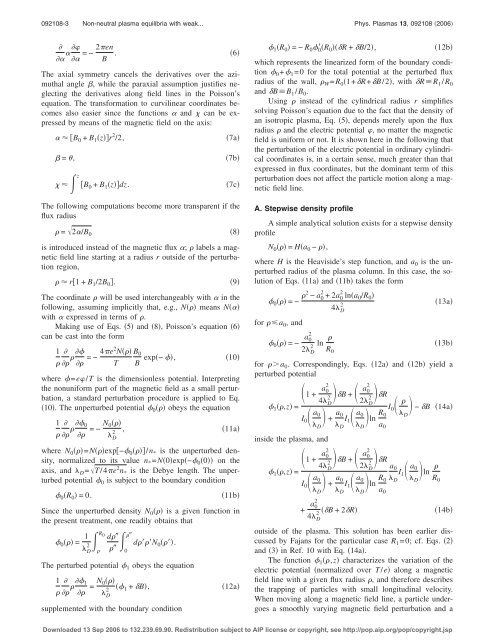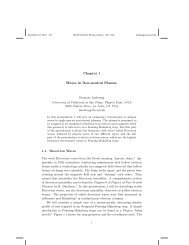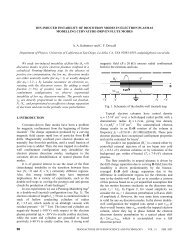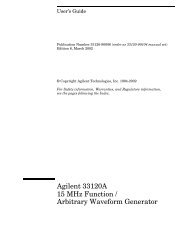Non-neutral plasma equilibria with weak axisymmetric magnetic ...
Non-neutral plasma equilibria with weak axisymmetric magnetic ...
Non-neutral plasma equilibria with weak axisymmetric magnetic ...
You also want an ePaper? Increase the reach of your titles
YUMPU automatically turns print PDFs into web optimized ePapers that Google loves.
092108-3 <strong>Non</strong>-<strong>neutral</strong> <strong>plasma</strong> <strong>equilibria</strong> <strong>with</strong> <strong>weak</strong>... Phys. Plasmas 13, 092108 2006<br />
<br />
=−2en B . 6<br />
The axial symmetry cancels the derivatives over the azimuthal<br />
angle , while the paraxial assumption justifies neglecting<br />
the derivatives along field lines in the Poisson’s<br />
equation. The transformation to curvilinear coordinates becomes<br />
also easier since the functions and can be expressed<br />
by means of the <strong>magnetic</strong> field on the axis:<br />
B 0 + B 1 zr 2 /2,<br />
= ,<br />
z B 0 + B 1 zdz.<br />
7a<br />
7b<br />
7c<br />
The following computations become more transparent if the<br />
flux radius<br />
= 2/B0<br />
is introduced instead of the <strong>magnetic</strong> flux ; labels a <strong>magnetic</strong><br />
field line starting at a radius r outside of the perturbation<br />
region,<br />
r1+B 1 /2B 0 .<br />
The coordinate will be used interchangeably <strong>with</strong> in the<br />
following, assuming implicitly that, e.g., N means N<br />
<strong>with</strong> expressed in terms of .<br />
Making use of Eqs. 5 and 8, Poisson’s equation 6<br />
can be cast into the form<br />
1 <br />
N B 0<br />
=−4e2 exp− ,<br />
T B 10<br />
where =e/T is the dimensionless potential. Interpreting<br />
the nonuniform part of the <strong>magnetic</strong> field as a small perturbation,<br />
a standard perturbation procedure is applied to Eq.<br />
10. The unperturbed potential 0 obeys the equation<br />
8<br />
9<br />
1 <br />
0<br />
=−N 0<br />
2<br />
, 11a<br />
D<br />
where N 0 =Nexp− 0 /n * is the unperturbed density,<br />
normalized to its value n * =N0exp− 0 0 on the<br />
axis, and D = T/4e 2 n * is the Debye length. The unperturbed<br />
potential 0 is subject to the boundary condition<br />
0 R 0 =0.<br />
11b<br />
Since the unperturbed density N 0 is a given function in<br />
the present treatment, one readily obtains that<br />
0 = 1 R 0<br />
d <br />
dN0 .<br />
D<br />
2 <br />
0<br />
The perturbed potential 1 obeys the equation<br />
1 <br />
1<br />
= N 0<br />
2<br />
1 + B, 12a<br />
D<br />
supplemented <strong>with</strong> the boundary condition<br />
1 R 0 =−R 0 0 R 0 R + B/2,<br />
12b<br />
which represents the linearized form of the boundary condition<br />
0 + 1 =0 for the total potential at the perturbed flux<br />
radius of the wall, W =R 0 1+R+B/2, <strong>with</strong> RR 1 /R 0<br />
and BB 1 /B 0 .<br />
Using instead of the cylindrical radius r simplifies<br />
solving Poisson’s equation due to the fact that the density of<br />
an isotropic <strong>plasma</strong>, Eq. 5, depends merely upon the flux<br />
radius and the electric potential , no matter the <strong>magnetic</strong><br />
field is uniform or not. It is shown here in the following that<br />
the perturbation of the electric potential in ordinary cylindrical<br />
coordinates is, in a certain sense, much greater than that<br />
expressed in flux coordinates, but the dominant term of this<br />
perturbation does not affect the particle motion along a <strong>magnetic</strong><br />
field line.<br />
A. Stepwise density profile<br />
A simple analytical solution exists for a stepwise density<br />
profile<br />
N 0 = Ha 0 − ,<br />
where H is the Heaviside’s step function, and a 0 is the unperturbed<br />
radius of the <strong>plasma</strong> column. In this case, the solution<br />
of Eqs. 11a and 11b takes the form<br />
0 =− 2 − a 2 0 +2a 2 0 lna 0 /R 0 <br />
2<br />
4 D<br />
for a 0 , and<br />
13a<br />
0 =− a 0 2<br />
2<br />
2 ln 13b<br />
D<br />
R 0<br />
for a 0 . Correspondingly, Eqs. 12a and 12b yield a<br />
perturbed potential<br />
1 ,z =<br />
inside the <strong>plasma</strong>, and<br />
1 ,z =<br />
1+ a 0 2<br />
4 D<br />
2B + a 0 2<br />
2 D<br />
2R<br />
I 0 a 0<br />
D + a 0<br />
I<br />
D<br />
1 a 0 R I<br />
0<br />
0 <br />
<br />
Dln<br />
a<br />
D − B 14a<br />
0<br />
1+ a 0 2<br />
4 D<br />
2B + a 0 2<br />
2 D<br />
2R<br />
a 0<br />
I 0 a 0<br />
D + a 0<br />
I<br />
D<br />
1 a 0 R I<br />
0 D<br />
1 a 0 <br />
Dln<br />
R 0<br />
Dln<br />
a 0<br />
+ a 0 2<br />
2<br />
B +2R<br />
4 14b<br />
D<br />
outside of the <strong>plasma</strong>. This solution has been earlier discussed<br />
by Fajans for the particular case R 1 =0; cf. Eqs. 2<br />
and 3 in Ref. 10 <strong>with</strong> Eq. 14a.<br />
The function 1 ,z characterizes the variation of the<br />
electric potential normalized over T/e along a <strong>magnetic</strong><br />
field line <strong>with</strong> a given flux radius , and therefore describes<br />
the trapping of particles <strong>with</strong> small longitudinal velocity.<br />
When moving along a <strong>magnetic</strong> field line, a particle undergoes<br />
a smoothly varying <strong>magnetic</strong> field perturbation and a<br />
Downloaded 13 Sep 2006 to 132.239.69.90. Redistribution subject to AIP license or copyright, see http://pop.aip.org/pop/copyright.jsp








![WORKSHOP PARTICIPANTS LIST [pdf] - UC San Diego](https://img.yumpu.com/35298899/1/190x245/workshop-participants-list-pdf-uc-san-diego.jpg?quality=85)
